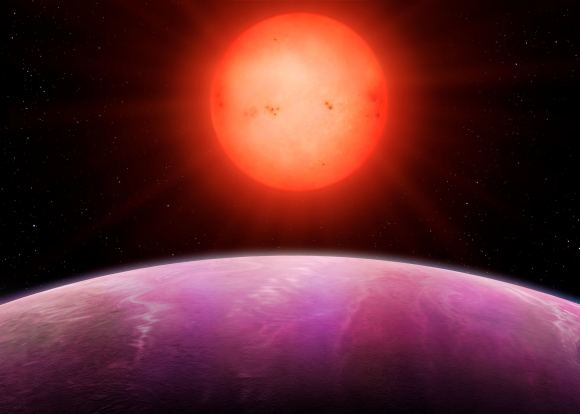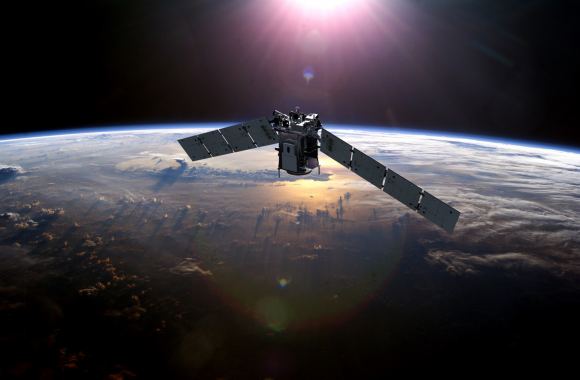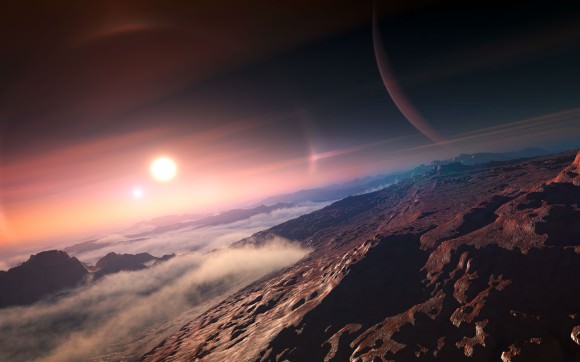Despite the thousands of exoplanets that have been discovered by astronomers in recent years, determining whether or not any of them are habitable is a major challenge. Since we cannot study these planets directly, scientists are forced to look for indirect indications. These are known as biosignatures, which consist of the chemical byproducts we associate with organic life showing up in a planet's atmosphere.
A new study by a team of NASA scientists proposes a new method to search for potential signs of life beyond our Solar System. The key, they recommend, is to takes advantage of frequent stellar storms from cool, young dwarf stars. These storms hurl huge clouds of stellar material and radiation into space, interacting with exoplanet atmospheres and producing biosignatures that could be detected.
The study, titled "Atmospheric Beacons of Life from Exoplanets Around G and K Stars", recently appeared in Nature Scientific Reports. Led by Vladimir S. Airapetian, a senior astrophysicist with the Heliophysics Science Division (HSD) at the NASA Goddard Space Flight Center, the team included members from NASA's Langley Research Center, the Science Systems and Applications Incorporated (SSAI), and the American University.

Beacons of life could help researchers identify potentially habitable worlds. Credits: NASA's Goddard Space Flight Center/Mary Pat Hrybyk
Traditionally, researchers have searched for signs of oxygen and methane in exoplanet atmospheres, since these are well-known byproducts of organic processes. Over time, these gases accumulate, reaching amounts that could be detected using spectroscopy. However, this approach is time-consuming and requires that astronomers spend days trying to observe spectra from a distant planet.
But according to Airapetian and his colleagues, it is possible to search for cruder signatures on potentially habitable worlds. This approach would rely on existing technology and resources and would take considerably less time. As Airapetian explained in a NASA press release:
"We're in search of molecules formed from fundamental prerequisites to life — specifically molecular nitrogen, which is 78 percent of our atmosphere. These are basic molecules that are biologically friendly and have strong infrared emitting power, increasing our chance of detecting them."
Using life on Earth as a template, Airapetian and his team designed a new method to look or signs of water vapor, nitrogen and oxygen gas byproducts in exoplanets atmospheres. The real trick, however, is to take advantage of the kinds of extreme space weather events that occur with active dwarf stars. These events, which expose planetary atmospheres to bursts of radiation, cause chemical reactions that astronomers can pick on.

Artist's impression of the cool red star above a distant exoplanet. Credit: University of Warwick/Mark Garlick.
When it comes to stars like our Sun, a G-type yellow dwarf, such weather events are common when they are still young. However, other yellow and orange stars are known to remain active for billions of years, producing storms of energetic, charged particles. And M-type (red dwarf) stars, the most common type in the Universe, remain active throughout their long-lives, periodically subjecting their planets to mini-flares.
When these reach an exoplanet, they react with the atmosphere and cause the chemical dissociation of nitrogen (N²) and oxygen (O²) gas into single atoms, and water vapor into hydrogen and oxygen. The broken down nitrogen and oxygen atoms then cause a cascade of chemical reactions which produce hydroxyl (OH), more molecular oxygen (O), and nitric oxide (NO) - what scientists refer to as "atmospheric beacons".
When starlight hits a planet's atmosphere, these beacon molecules absorb the energy and emit infrared radiation. By examining the particular wavelengths of this radiation, scientists are able to determine what chemical elements are present. The signal strength of these elements is also an indication of atmospheric pressure. Taken together, these readings allow scientist's to determine an atmosphere's density and composition.
For decades, astronomers have also used a model to calculate how ozone (O³) is formed in Earth's atmosphere from oxygen that is exposed to solar radiation. Using this same model - and pairing it with space weather events that are expected from cool, active stars - Airapetian and his colleagues sought to calculate just how much nitric oxide and hydroxyl would form in an Earth-like atmosphere and how much ozone would be destroyed.

Artist's concept of NASA's TIMED spacecraft, which has been observing Earth's upper atmosphere for 15 years. Credits: NASA/JHU-APL
To accomplish this, they consulted data from NASA's Thermosphere Ionosphere Mesosphere Energetics Dynamics (TIMED) mission, which has been studying the formation of beacons in Earth's atmosphere for years. Specifically, they used data from its Sounding of the Atmosphere using Broadband Emission Radiometry (SABER) instrument, which allowed them to simulate how infrared observations of these beacons might appear in exoplanet atmospheres.
As Martin Mlynczak, the SABER associate principal investigator at NASA's Langley Research Center and a co-author of the paper, indicated:
"Taking what we know about infrared radiation emitted by Earth's atmosphere, the idea is to look at exoplanets and see what sort of signals we can detect. If we find exoplanet signals in nearly the same proportion as Earth's, we could say that planet is a good candidate for hosting life."
What they found was that the frequency of intense stellar storms was directly related to the strength of the heat signals coming from the atmospheric beacons. The more storms occur, the more beacon molecules are created, generating a signal strong enough to be observed from Earth with a space telescope, and based on just two hours of observation time.

An exoplanet seen from its moon (artist's impression). Credit: IAU
They also found that this kind of method can weed out exoplanets that do not possess an Earth-like magnetic field, which naturally interact with charged particles from the Sun. The presence of such a field is what ensures that a planet's atmosphere is not stripped away, and is therefore essential to habitability. As Airapetian explained:
"A planet needs a magnetic field, which shields the atmosphere and protects the planet from stellar storms and radiation. If stellar winds aren't so extreme as to compress an exoplanet's magnetic field close to its surface, the magnetic field prevents atmospheric escape, so there are more particles in the atmosphere and a stronger resulting infrared signal."
This new model is significant for several reasons. On the one hand, it shows how research that has enabled detailed studies of Earth's atmosphere and how it interacts with space weather is now being put towards the study of exoplanets. It is also exciting because it could allow for new studies of exoplanet habitability around certain classes of stars - ranging from many types of yellow and orange stars to cool, red dwarf stars.
Red dwarfs are the most common type of star in the Universe, accounting for 70% of stars in spiral galaxies and 90% in elliptical galaxies. What's more, based on recent discoveries, astronomers estimate that red dwarf stars are very likely to have systems of rocky planets. The research team also anticipates that next-generation space instruments like the James Webb Space Telescope will increase the likelihood of finding habitable planets using this model.

This artist's impression shows the planet orbiting the star Alpha Centauri B, a member of the triple star system that is the closest to Earth. Credit: ESO
As William Danchi, a Goddard senior astrophysicist and co-author on the study, said:
"New insights on the potential for life on exoplanets depend critically on interdisciplinary research in which data, models and techniques are utilized from NASA Goddard's four science divisions: heliophysics, astrophysics, planetary and Earth sciences. This mixture produces unique and powerful new pathways for exoplanet research."
Until such time that we are able to study exoplanets directly, any development that makes biosignatures more discernible and easier to detect is incredibly valuable. In the coming years, Project Blue and Breakthrough Starshot are hoping to conduct the first direct studies of the Alpha Centauri system. But in the meantime, improved models that allow us to survey countless other stars for potentially habitable exoplanets are golden!
Not only will they vastly improve our understanding of just how common such planets are, they might just point us in the direction of one or more Earth 2.0s!
Further Reading: NASA, Nature Scientific Reports
No comments:
Post a Comment